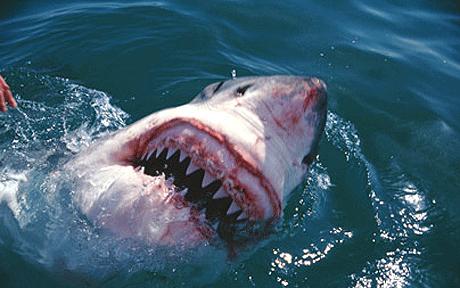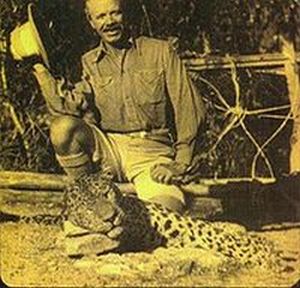A man-eater is a term that describes an animal that preys on humans. Most reported cases of man-eaters have involved tigers, leopards, lions and crocodilians. However, these species are not the only predators that will attack humans. In most cases, when an animal mauls a human they are defending their territory or children. On a large scale, predatory attacks on people are rare and humans are more likely to be killed by fellow hunters. In North America alone, over 100 people are killed annually by hunters. When measuring human deaths by mauling, the domestic dog is the most deadly animal in the United States, killing around 35 people a year. Most of the victims are small children. One of the most terrifying experiences a person can face is being targeted and hunted by a large predatory animal. This article will be examining 10 cases of deadly animal attacks on humans.
1.
Battle of Ramree Island
Killer: Saltwater Crocodile
The saltwater crocodile is the largest of all living reptiles. The species is found across Northern Australia, the eastern coast of India and parts of Southeast Asia. An average adult male saltwater crocodile weighs 600 to 1,000 kilograms (1,300–2,200 lb), with a length of 4.1 to 5.5 meters (13–18 ft). However, mature males can reach 6 meters (20 ft) or more and weigh 1,300 kilograms (2,900 lb) or larger. A population of saltwater crocodiles lives near Ramree Island, which is located off the coast of Rakhine State, Burma. Ramree Island is situated in the Bay of Bengal, and separated from the mainland by tidal flats at the mouth of the River An.
Towards the end of World War II, Ramree Island was the site of a violent battle waged between the Imperial Japanese Army and the Allied Troops. The Allies were attempting to regain the island and build a military sea-supplied airbase. On January 26, 1945 the Royal Marine and the 36th Indian Infantry Brigade force landed on Ramree Island. The marines quickly outflanked a Japanese stronghold and this caused thousands of Japanese soldiers to retreat across the island, where a larger battalion was positioned. The route forced the Japanese to cross 16 kilometers of mangrove swamps and thick forests. The marshes were littered with large saltwater crocodiles, scorpions, and deadly mosquitoes. The British forces encircled the swampland and prevented the Japanese from escaping. They did continually urge the soldiers to surrender, but nobody did.
It is unclear exactly how many Japanese soldiers entered the marshes of Ramree Island, but the accepted number is between 500-1000, with only 20 survivors. It has been reported by numerous individuals that during the battle hundreds of Japanese soldiers were attacked and mauled by saltwater crocodiles. Soldiers have recounted and described the horrific events that plagued the island. At night the crocodiles would appear and attack people by the dozens. The soldiers regularly reported the sound of thrashing animals, screams, and people being eaten alive. Numerous sources have also described the vast amount of vultures that entered the swamps during the day. The Guinness Book of Records lists the Ramree Island crocodile massacre as the largest catastrophe against humans by animals in history.

2.
2010 Surf Beach Incident
Killer: Great White Shark
The great white shark is a large species of shark that is found in all the world’s major oceans. The animal is well known for its size, with the largest individual having approached or exceeded 6 meters (20 ft) in length and 2,268 kilograms (5,000 lb) in weight. Sharks lurk below the surface of the water and prey on many sea species. They are ambush hunters and capable of removing entire human limbs without hesitation. Luckily, it seems that sharks prefer to stay away from humans and are rarely known to attack people. However, in some cases people are bitten and confused for another species. Every year, sharks kill dozens of individuals around the world. On October 22, 2010 a college student named Lucas McKaine Ransom was attacked by a great white shark while boogie boarding with some friends approximately 100 yards (91 m) off Surf Beach near Vandenberg Air Force Base in Santa Barbara County, California.
It has been reported that within the blink of an eye, Lucas Ransom was taken under the water with incredible force and a cloud of blood began to appear around his body. One of Lucas good friends Mathew Garcia was surfing two feet away from him when the incident occurred. Garcia courageously dragged his screaming friend to shore, but when they arrived it was evident that Lucas Ransom’s leg was missing and he died on the scene. After the attack, Surf Beach was closed down until authorities could investigate the case. Evidence was gathered from the scene and Ransom’s boogie board, which suffered a large bite mark, was examined. It has since been confirmed that a great white shark was responsible for the attack on Lucas Ransom. The animal is believed to have been between 17–18 feet (5.2–5.5 m) long, weighing perhaps 4,000 pounds (1,814 kg).
The largest reported case of mass shark attacks occurred in the wake of the 1945 sinking of the USS Indianapolis. On July 30, 1945 the USS Indianapolis was destroyed by an Imperial Japanese Navy submarine. The event marked the greatest single loss of life at sea in the history of the U.S. Navy. Of the 1,196 crew aboard the vessel, approximately 300 were killed in the initial blast, but the remaining 880 soldiers entered the Pacific Ocean and faced exposure, dehydration and mass shark attacks. In fact, the ship wreck was not discovered by the US military until 4 days later, when survivors were spotted by a routine patrol. In all, over 550 people were killed in the ocean while waiting for rescue. Many of the men had life preservers, which prevented them from drowning. However, the survivors would later discuss the large amount of shark attacks that occurred in the days following the sinking. They described a scene of horror, as the animals stalked and preyed on defenseless people. The sinking of the USS Indianapolis was recalled in Steven Spielberg’s 1975 movie Jaws.

3.
Leopard of Rudraprayag
Killer: Leopard
The leopard is a member of the Felidae family and the smallest of the four big cats, which include the tiger, lion and jaguar. In the last 50 years, the leopard’s range of distribution has decreased radically due to hunting and loss of habitat. The animal is now primarily found in sub-Saharan Africa. The leopard has relatively short legs and a long body with a large skull. The cats are very fast and can reach speeds approaching 58 kilometers per hour (36 mph). While most leopards avoid people, humans may occasionally be targeted as prey. Most healthy leopards prefer wild animals for food, but injured, sickly or struggling cats may resort to hunting humans and become habituated to it. Man-eating leopards are considered bold and may enter human settlements for prey, even more so than lions and tigers. Two extreme cases of killer leopards have occurred in India. The first animal, the Panar Leopard, is said to have killed over 400 people. The second creature, the Leopard of Rudraprayag , is believed to have mauled more than 125 individuals.
In 1917, the first person was killed by the Rudraprayag Leopard. Rudraprayag is a district in the Indian state of Uttarakhand. For eight years, no one dared travel alone at night on the road between the Hindu shrines of Kedarnath and Badrinath, for it passed through the leopard’s territory. The leopard was apparently so desperate for food that it would break down doors, leap through windows, claw through walls and drag people from their homes, devouring them. The British Parliament requested the aid of legendary big game hunter Jim Corbett. Corbett had already killed the Panar Leopard in 1910. In the autumn of 1925, Jim Corbett tracked and killed the Rudraprayag Leopard. After analysis, it was noted that the animal was suffering from serious gum recession and tooth loss, which is thought to have contributed to the decision to attack humans. Today, there is still an annual fair held at Rudraprayag commemorating the killing of the leopard. The people there often consider Jim Corbett a Sadhu.

4.
San Francisco Zoo Attack
Killer: Tiger
The tiger is one of the largest carnivores in the world. They are territorial and solitary creatures. Tigers require a large contiguous area of habitat and abundant diet. For this reason, in many densely populated places on Earth, tigers are extinct. In fact, three of the nine subspecies of modern tiger have gone extinct, and the remaining six are classified as endangered. Tigers are big, strong, violent, and predatory creatures. History books are full of cases involving infamous human killing tigers. Probably the most famous is the Champawat Tiger that was allegedly responsible for 436 documented deaths in Nepal and the Kumaon area of India during the 19th century. After having killed over 200 people in Nepal, the tigress was driven by the Nepalese Army across the border into India, where she continued her activities in the Kumaon District. However, the Champawat Tiger was eventually killed by Jim Corbett in 1911.
In separate incidents, captured tigers have been known to escape their enclosures and attack humans. One of the best known cases took place at the San Francisco Zoo on Christmas Day, 2007. Tatiana was a tigress that was brought to the San Francisco Zoo on December 16, 2005 to provide a mate for a 14-year-old Siberian tiger. Tatiana showed her first signs of violence on December 22, 2006 when she clawed and bit a veteran zookeeper named Lori Komejan. Komejan’s arm was pulled between the cage bars and severely injured as a result. However, the most deadly incident involving Tatiana occurred on Christmas Day, 2007, when she jumped over her enclosed wall and entered the zoo. After escaping from the tiger grotto, Tatiana mauled and killed Carlos Eduardo Sousa Jr. by slashing his jugular vein. He was only 17-years-old.
The tiger then attacked and injured two brothers. Luckily, the event occurred as the zoo was closing and only a small number of people were inside. One of the brothers was able to escape from the tiger, but the other was left injured on the pavement, with Tatiana standing guard. The scene was chaotic and police were delayed in their arrival to the zoo. However, around 20 minutes after her escape, Tatiana was shot and killed by a zoo shooting team member. The Dhaliwal brothers received deep bites and claw wounds on their heads, necks, arms, and hands, but survived the incident. The attack was the first visitor fatality due to an animal escape at a member zoo, in the history of the Association of Zoos and Aquariums. People need to respect the power and ferocity of these animals. Just ask Nordin Montong, who decided to jump into the white tiger enclosure at the Singapore Zoo in 2008. Upon entering the tiger’s home, Montong provoked the animals with a broom and pail. In response, three of the tigers mauled him to death.

5.
Soda Butte Campground Attack
Killer: Grizzly Bear
The brown bear is a large bear species distributed across much of northern Eurasia and North America. The predators can weigh from 300 to 780 kilograms (660 to 1720 lbs). The grizzly bear is a subspecies of brown bear that can be found in the uplands of western North America. The grizzly bear is generally a solitary creature and largely eats plants, which make up 80%–90% of the animal’s diet. However, the grizzly bear is a carnivore and regularly feeds on moose, deer, sheep, elk, bison, caribou and even black bears. Grizzlies are considered by some experts to be the most aggressive species of brown bear in the world. Adult grizzlies are too large to escape danger by climbing trees, so they respond by standing their ground and fighting. Grizzly bears generally don’t attack humans for food. The most common reason for a grizzly attack on a person is a mother defending her cubs. These types of attacks are responsible for 70% of fatal injuries to humans. In spite of their obvious physical advantages and many opportunities, grizzly bears almost never view humans as prey and rarely actively hunt people.
Many traits that scientists understand about grizzly bears do not apply to the events that occurred on July 28, 2010 in the Soda Butte campground of Gallatin National Forest, which is located on the northern edge of Yellowstone Park. Soda Butte campground is a large overnight site that is regularly packed with tourists visiting Yellowstone during the summer months. On the day in question, a man named Kevin Kammer was camping in the Soda Butte campground while on vacation in Yellowstone. Brown bears usually avoid large public camp grounds at night and stay away from packs of people. However, on the night of July 28, a mother grizzly bear with three small cubs went on a coordinated rampage in the Soda Butte campground. Moving from different angles, the bear was responsible for three separate attacks on people sleeping in their tents. Keven Kammer was pulled from his sleeping bag and mauled to death 7.6m (25 feet) away from his tent.
A woman named Deb Freele was attacked while sleeping in the middle of the night. She was bitten on her wrist and leg, crushing bones. Deb then instinctively played dead and the grizzly bear left her alone. This is strange, because if the bear was looking for food then Deb would have been killed. After Deb was attacked, the same bear plowed through a teenage boy’s tent and bit him on the leg. The boy punched the bear in the face and this caused it to flee into the woods. The events have changed the way people view bears in Yellowstone. The incident showed that certain bears are not afraid to enter public campgrounds at night and that tents provide little protection from the animals. A tent will not stop a determined grizzly bear. The mother grizzly bear responsible for the death of Kevin Kammer was trapped by park officials using pieces of a culvert and Kevin’s tent. The grizzly bear was later studied and euthanized. Her cubs were removed from the park and sent to ZooMontana. The deadly incident remains the most brazen grizzly bear attack in the Yellowstone area since the 1980s.

Thanks to CK Claims – the animal attack compensation specialists – for supporting this post.







